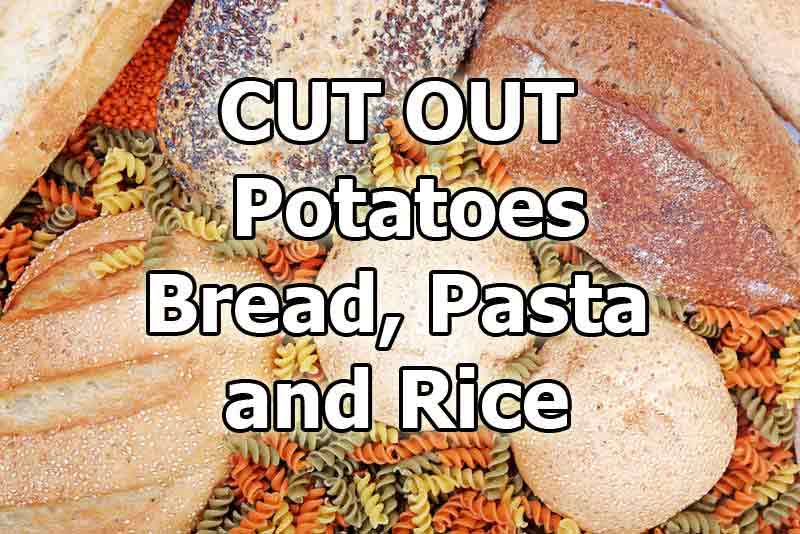Carbs, starches, and sugars, oh my!
What is the difference between these three things, and why should you avoid them on a type 2 diabetes diet?

Carbs, Starches, and Sugar: What’s the Difference?
It’s easy to get confused when talking about carbohydrates because “carbs” is just an umbrella category that encompasses starches, sugars, and also fibres. The terms “carbs” and “sugars” are basically interchangeable because all digestible carbohydrates eventually break down into simple sugars and are absorbed into the bloodstream.
What’s the difference between carbs/sugars and starches, then?
Sugars are simple molecules that don’t require much digesting; they are absorbed into the blood stream immediately. Think of candy, fruit juice, and soda. They give you a quick burst of energy (but can leave you feeling drained later) because they’re taken up by the body so quickly.
Starches are made up of long chains of sugars. Think of rice, corn, and potatoes. They require a little bit more digestion to be absorbed, but they still break down into carbohydrates/sugars.
Sometimes we hear of these carbohydrates referred to as simple or complex carbohydrates.
While complex carbs are usually a better choice over simple carbs, there is a bit more to the story. You see, both sugars and starches aren’t great for blood sugar regulation because they are higher in carbs. And the truth of the matter is while quality of carbs is important, research shows quantity is what makes the most impact.
That means sugars and starches (many of which are complex carbs) are best limited or avoided altogether.
What About Fibre?
Fibre is technically a carbohydrate, but we don’t lump fibre-rich foods in with “high carb” foods because fibre is a non-digestible carbohydrate.
Instead of causing sudden spikes in blood sugar, fibre helps to stabilise blood sugar levels by causing the other carbs in a meal to be absorbed more slowly. This slowed absorption acts as a “buffer” so that blood sugar levels rise more gently and evenly.
This is where the concept of a “simple carb” verses a “complex carb” comes into play.
Simple carbs are those that don’t have a very good carb-to-fibre ratio, and they also tend to be processed foods.
Complex carbs have their natural fibre in tact and are usually less processed. That being said, the most important thing to worry about when you have type 2 diabetes is the amount of total carbs in any given food.
Brown rice, for example, is technically a complex carb because it contains a little fibre…but at 40g of carbs per cup, it still has way too many carbs to be worth your while!
Fibre also plays many other important roles in the body, such as:
- improving digestion and bowel health
- feeding gut bacteria
- controlling blood sugar and cholesterol levels
- reducing inflammation
- curbs carb cravings
Type 2 Diabetes Foods to Avoid
These first three categories tend to get the most raised eyebrows, as most people grew up learning that all vegetables, legumes, and grains were super healthy.
The truth is that even whole grains and some veggies aren’t great for blood sugar control because of their carb content.
Starchy Vegetables
Starchy veggies like potatoes, sweet potatoes, yams, plantains, parsnips, and corn contain a lot of carbs and are best avoided.
Instead of these, replace with more friendly vegetables such as carrots, pumpkin, and beetroot.
When in doubt, stick with the low carb veggies you know you enjoy and can tolerate well.
High and Moderate Carb Legumes
Avoid big servings of legumes like lentils, beans, and chickpeas.
While beans and legumes do contain some protein, they are mainly a carbohydrate food.
Some people with diabetes may be able to tolerate small amounts of beans and legumes (about 1/4 cup per serve). Others may not be able to tolerate any.
With any beans and legumes, keep your portions small and load up the rest of your plate with other very low carb foods to balance things out.
Grains
Stay away from starchy and high-carb grains like rice, oats, wheat, barley, millet, and grain-based noodles and flours.
It’s easy to wrack up dozens (if not hundreds) of grams of carbs in a single day by indulging in too many grains.
A single cup of rice contains about 45g of carbs.
A cup of wholegrain pasta starts at around 35g of carbs, and that’s before adding any sauces or sides.
A slice of wholemeal bread has around 10-15g of carbs. having whole sandwich? Make that two slices of bread for a total of at least 20-30g of carbs!
As you can see, the carbs add up super quickly when you’re consuming grains and those higher carb foods tend to prevent you from obtaining better blood sugar control. This is why we put grains on the “no list”! Or at least on the “odd occasion” food list!

Sugary Fruits
Pineapple, mango, banana and many other fruits just contain too much sugar!
While there are still plenty of lower carb fruits to enjoy, most of the super-sweet fruits out there are off limits.
Sweets
This may be the most obvious category to avoid, but it’s still a good refresher.
Sugar-packed sweets and beverages are simple carbs that you’ll want to avoid at all costs!
These may include:
- Pastries like doughnuts, breads, muffins, cupcakes and more
- Desserts like candy, ice cream, cakes, pies, and cookies
- Sweetened beverages like hot chocolate, soda, energy drinks, fruit juice, specialty coffees, and alcoholic mixed drinks or ciders
What Can I Eat On A Low Carb Diet?
That may seem like a lot of foods that are best to avoid with type 2 diabetes, but there are actually many nutritious and satisfying options out there for you to love instead.
A healthy low carb diet is rich in healthy fats, hearty protein sources, low sugar fruits, fresh veggies, and low-carb replacements for some of your high-carb favourites. There are still bread options, blood sugar-friendly alternative for sugar, and tasty sweet treats you can eat.
In fact, you can eat many foods in abundance, enjoy what you eat, and regulate blood sugar at the same time.
Check out this low carb foods list and some helpful low carb guidelines for ideas and inspiration to keep your blood sugar and health in check!

